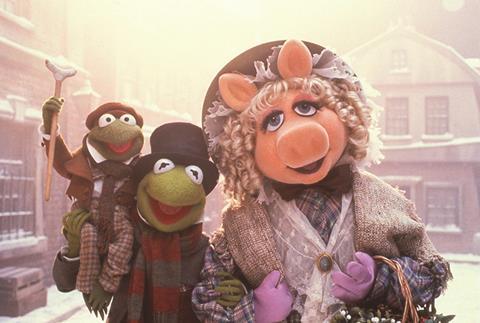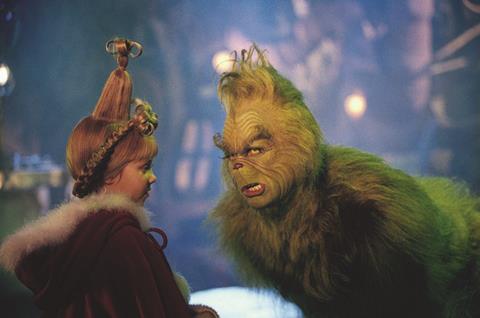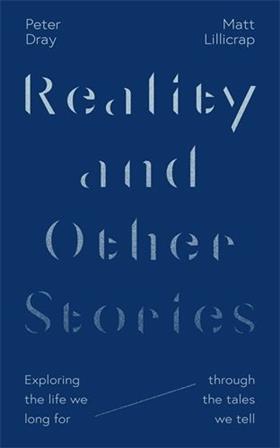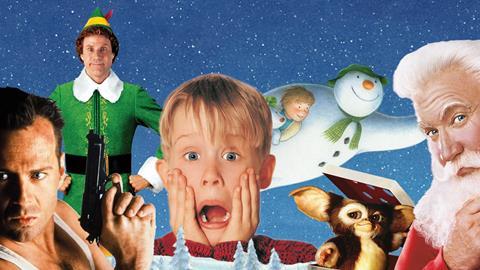From Home Alone to The Polar Express, every tale we tell points back to the greatest story ever told
Family and friends, presents and parties, turkey and the trimmings. Decorations, excitement and, of course, joy. Warm firesides and snow-covered landscapes. Carol singers huddling around a frost-laden tree, singing songs of goodwill into the freezing air.
A world tinged with enchantment, magically alive. We are approaching, in short, “the most wonderful time of the year”.
But why do scenes like these come to mind when we think about Christmas? The answer: they owe themselves to the stories we rehearse and share about this festive season. In turn, these stories provide the backdrop for our real lives as we hope to live out magic-infused Christmastime moments.
The only way to make sense of our lives – at Christmastime or any other time of the year – is to tell stories. And, intriguingly, as we tell these stories, we employ a very limited number of story shapes. What that tells us about human nature is intriguing.

The shape of a story
Christopher Booker spent nearly four decades studying stories from across the world and throughout human history. Noticing the similarities that these stories had with one another, Booker ventured that all stories draw from seven basic plotlines (see box). In other words, though storytellers are immensely creative, they find themselves painting from the same palette of seven story shapes.
Since Booker published his 2004 book The Seven Basic Plots (Bloomsbury Academic), theorists have debated his findings. Some suggest there are only three, others five, still others believe there are up to 30. Nevertheless, virtually all concede that many of our favourite stories bear remarkable resemblance to each other.
How the 7 types of story work
1. Overcoming the monster
Jaws, James Bond, Beowulf
A powerful evil which threatens the world and wreaks havoc is eventually overcome by a weaker good opponent, often in very unlikely circumstances. Stories that reflect this illustrate our desire that malevolent forces might be conquered in a way that doesn’t cause us to back an even bigger bully.
The Bible picks up this plotline as Jesus overcomes all evil forces and gives the cosmos a fresh start, not through a display of muscle, but through the weakness and humiliation of his own death.
2. Rags to riches
Aladdin, Cinderella, Slumdog Millionaire
A destitute and overlooked person receives a sudden opportunity to show who they really are, thereby securing public honour. Rags to riches stories reflect our deep wish to be seen, welcomed and cherished. Jesus satisfies this desire, by dealing with what is truly shameful in our lives yet loving and honouring us nonetheless.
3. The quest
The Odyssey, The Lord of the Rings, Ocean’s Eleven
Something suddenly jolts a character out of their established rhythms: a sense of destiny knocks, or they receive a golden opportunity for glory, and this new mission soon tests them to the limit.
Quest stories suggest that humans must move forward to live, and that true life is found not in pampered comfort but in being challenged and stretched. Jesus’ invitation to follow him is unique in the extent to which it stretches us, but our sure future means that no step along the path is wasted.
4. Voyage and return
Alice in Wonderland, The Wizard of Oz, Back to the Future
The hero is transported to a new place. At first, they feel freed of the stifling expectations of home, but they soon discover a darker edge to their new context. With relief they’re eventually returned home, only to find that they now appreciate it in new ways.
These stories reflect our desire for a place and a people to whom we belong, but they also highlight our tendency to resent everyday graces. Jesus not only gives us new capacity to appreciate what we may currently take for granted, but also offers us a home in which we belong .
5. Tragedy
Macbeth, Titanic, The Social Network
Tragedy stories pose questions: what if your guiding ambition does not lead to life, but to death? Tragedies speak of how good human desires can be misdirected and miscalibrated to devastating effect – something that tragic characters only recognise when it’s too late.
Jesus warns us that what we treasure is of eternal importance and that, without him, each of us is living a tragedy. He offers us a way out, if we will only turn to him.
6. Comedy
Pride and Prejudice, Bridget Jones’s Diary, High School Musical
In most comedies, we can sense the ‘happy-ever-after’ we long for early on in the action, but it seems constantly out of reach. Not only do characters misunderstand each other’s motives, they are also locked into circumstances that seem to prevent the uplifting ending we long for. But then light breaks in: suddenly characters see things for how they really are, and the happiest of conclusions takes shape.
As hopeless as things may seem, the universe is made not just for uplifting endings here and there but a great Happy Ever After – which Jesus’ resurrection provides.
7. Rebirth
Beauty and the Beast, Groundhog Day, The Lion King
Rebirth stories are accounts of ‘tragedy interrupted’. A character who seems hopeless and helpless is dramatically transformed, with stunning effect. Rebirth stories whisper to us that no one is a write-off and that once a person is made ‘new’, the whole world benefits from the change.
Rebirth stories are evident throughout the Bible: it is only in knowing Jesus that we can truly be born again and discover more deeply who we really are.
The Christmas shaped story
Christmas demonstrates this in abundance. Although we might argue about whether Die Hard is really a Christmas movie (for the record, Matt insists it is, while Peter vehemently disagrees), we still instinctively know a Christmassy story when we come across one. We recognise the emotions, nostalgia, wonder and joy that Christmas stories evoke.
In fact, the annual Die Hard debate has spawned countless online checklists outlining the components of any true Christmas movie. Everyone recognises the first: in a Christmas film, there must be magic in the air.
A child raised among elves makes his way to New York; an other-worldly train arrives to take a sceptical child to the North Pole; a snowman comes to life; a miserly bachelor is visited by three Christmas spirits.
This magical element isn’t simply there for fun. It leads to heart-warming transformation, which is the second major ingredient in virtually every Christmas film. Buddy the elf is reconciled with his father and starts a family of his own.
Billy’s scepticism is banished in The Polar Express, while The Snowman’s James finds his world infused with fresh wonder after walking in the air. And, of course, Christmas wouldn’t be Christmas without a fresh start for at least one Scrooge.

We might find it remarkable enough to recognise that there are seven basic plots – yet, more remarkable still, is that at Christmas virtually all the stories we consume employ just two of them.
Many contain a ‘voyage and return’ plotline: a protagonist is forced away from the normality of home, before eventually returning, seeing everything with fresh eyes. Think of George Bailey in It’s a Wonderful Life, returning to Bedford Falls having been shown, by a guardian angel, what his town would have looked like without his good deeds.
The other common festive theme is ‘rebirth’: a doomed and tragic character experiences dramatic change and their life is never the same again. It’s the plotline of How the Grinch Stole Christmas, The Santa Clause and, most famously, Charles Dickens’ A Christmas Carol.
The limited range of Christmas story shapes might mean these movies are almost as predictable as what’s on our TV screens over the festive period! But the question is: why?
Making sense of stories
Perhaps the most common idea about stories today is that they’re simply human inventions; accounts we project upon our ultimately pointless existence to try to make sense of it all. According to this view, we spot patterns in the world, ascribe them meaning and cement them into our understanding through narrative.
Christmas stories are therefore just a fantasy that humans have projected onto a meaningless world to make winter more enjoyable.
Every story in our culture points towards Jesus, whether faintly or in full stereo
Christians have a better answer, and a better story still to tell at Christmas. Our account begins with a world created by God, which has meaning baked into it. Given that we live in his world, it’s not surprising that we tell stories with recurring plotlines.
This isn’t so much an attempt to force meaning onto the world, as a reflection that we share hopes and longings formed by the world we live in. Rather than being like architects, imagining and creating meaning from whatever raw material we find, humans are more like archaeologists, digging up meaning that is already there, hidden in plain sight.
The reason we resonate with stories – and especially those that exemplify the seven basic plots – is not because they offer us an escape from a future characterised by oblivion. We resonate with them because they strike a chord with the deep desires that the eternal God has set within our hearts, calling us to embrace true humanity and to know life with him.
In other words, our shared human desires, which relentlessly bubble to the surface and are reflected in the contours of every tale we tell, beckon us to life with the living God, who alone can satisfy our deepest longings.
So what does this mean for Christmas stories? What do they tell us about the life we long for?
I’ll be home for Christmas
Whether we join James’ flight to the North Pole or Billy’s journey on the Polar Express, we love Christmas stories that invite us into adventures in faraway lands. Our real delight, though, comes as the hero returns home, discovering that everything that once seemed ordinary is now coloured by wonderment.
One of our children’s favourite Christmas movies has this effect. In an unusual way, Home Alone employs a voyage and return plotline. After Kevin wishes his family would disappear, a comic turn of events sees him living in a Christmas world without them.
At first it thrills him, but Kevin’s dream soon becomes a nightmare. Though we delight in the slapstick comedy that follows, the emotional power of the film comes as Kevin begins to recognise what he has long taken for granted: his family. Their eventual reunion returns Kevin himself to his home with a new-found appreciation for them all (even big brother Buzz!)
Stories strike a chord with the deep desires God has set within our hearts
Voyage and return stories like these highlight our tendency to take things and people for granted. Fascinatingly, the original written version of The Snowman lacked James’ visit to Santa. Raymond Briggs, the story’s creator, explained that it was about endings: “The snowman melts, my parents died, animals die, flowers die. Everything does.”
While the addition of Santa to the animated version adds a spark of wonder and hope, the poignant undertone remains. At Christmastime, voyage and return stories celebrate the profound beauty we often overlook in everyday life. By giving a glance at an alternate reality, they urge us not to be blind to today’s blessings or undervalue our loved ones in the bustle of the season.
All I want for Christmas
Alongside our desire for a re-enchanted world, we long for the promise of change that Christmas offers. In the words of Booker, we long for rebirth.
After all, Christmas changes everything. It doesn’t matter what radio station you usually listen to, they’re all suddenly playing Shakin’ Stevens and Wizzard. Even Classic FM starts playing orchestral versions of ‘Merry Xmas everybody’ and ‘Fairytale of New York’.
The same thing happens to our food. We rarely give roast turkey and sprouts a second thought unless, of course, it’s Christmas!
These annual changes in soundtrack and cuisine mirror our deeper hope that at Christmastime, we too might be changed. This is why A Christmas Carol is told and retold year after year. We marvel at the outright cruelty of Ebenezer Scrooge because it makes his rebirth all the more breathtaking.
Dickens’ classic poses many questions: what power can break through such a withered, selfish heart? What power can reconcile broken families, or help cynical adults recover childlike wonder? The same one that powers Santa’s magical sleigh, of course: Christmas spirit!

Yet there’s a problem. We repeat this same Christmas story every year. The same changes hold for a few weeks; the same vague anticipation that perhaps “next year will be different” builds. Then comes the same hollow emptiness as January comes, Christmas is over and the only thing changed is the size of our waistlines!
Fired by Christmas stories of rebirth, for a few breathless December days we touch the edge of something transformative – a sense that there is more to who we could be – only to find it slipping through our fingers as we try to grasp it.
The true magic of Christmas
Virtually every Christmas story of rebirth told today is inspired by Charles Dickens’ A Christmas Carol. Dickens’ own history hints at why these tales are so tantalising yet disappointing. Disillusioned by the Church, Dickens rejected Christianity in his 30s. Though it is set at Christmastime, A Christmas Carol never once mentions Christ. For a Victorian novel, the silence is deafening.
Dickens knew that the rhythms of our annual Christmas traditions offer opportunity to reflect on how we’ve lived. It’s a deeply human desire to want to be better. Through Scrooge’s change of heart, Dickens implies that anyone can be transformed, if they only look within and understand their own story. For Scrooge, all this comes without any need for Jesus.
The power of Dickens’ story relies on our deep desire for rebirth, just as the emotional power of Home Alone relies on our longings for relationship – yet, tragically, both ultimately direct us to human goodness and mere “Christmas spirit”.
There is a Christmas story not written by human hands

But there is a Christmas story not written by human hand, but inscribed on the pages of history. At the centre lies the Holy Child of Bethlehem, who can cast out our sin, enter in and be born in us today.
Since they feed on and reveal our deepest longings, every story in our culture points towards Jesus, whether faintly or in full stereo – including (and perhaps especially) those dominating our screens over the festive period. T
he Christmas stories we enjoy tug on our desires and uncover our longings, but Jesus alone is the one to whom those desires and longings point. He promises to dispel the doom that awaits us and grants us transformation that can bring us home at last.
And that really is truth enough to make Christmas the most wonderful time of the year.
Matt Lillicrap and Peter Dray are the authors of Reality and Other Stories (IVP)

































1 Reader's comment